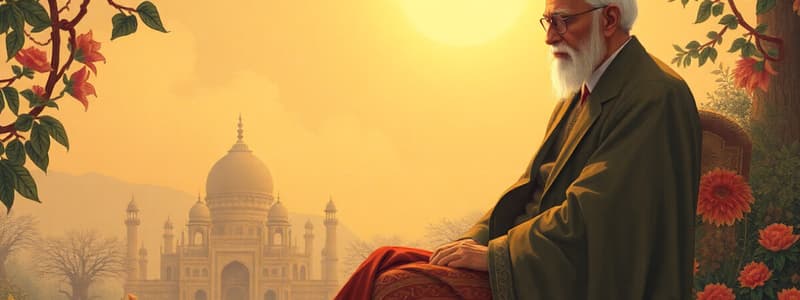Podcast
Questions and Answers
What impact does economic and security dependence on powerful states have on developing nations' foreign policy?
What impact does economic and security dependence on powerful states have on developing nations' foreign policy?
- It allows them to have complete independence in their foreign relations.
- It encourages them to develop their own distinct foreign policies.
- It entirely removes their ability to make autonomous decisions.
- It often leads them to align with the foreign policies of more powerful states. (correct)
What historical context influenced the alignment of many developing nations after the Second World War?
What historical context influenced the alignment of many developing nations after the Second World War?
- The rise of global economic cooperation agreements.
- The establishment of the United Nations and its peacekeeping missions.
- The influence of the United States and its western allies, as well as the Soviet Union. (correct)
- The growth of regional trade blocs in Asia and Europe.
What was the Non-Aligned Movement primarily focused on?
What was the Non-Aligned Movement primarily focused on?
- Encouraging developing nations to adopt capitalist ideologies.
- Creating economic dependencies with world powers.
- Promoting independence from the influence of both the United States and the Soviet Union. (correct)
- Establishing military alliances with both superpowers.
How did the end of the Cold War change the context of international relations?
How did the end of the Cold War change the context of international relations?
What is a characteristic goal of developing nations in international relations?
What is a characteristic goal of developing nations in international relations?
What was the first summit of the Non-Aligned Movement (NAM) held?
What was the first summit of the Non-Aligned Movement (NAM) held?
Who was a co-founder of the Non-Aligned Movement?
Who was a co-founder of the Non-Aligned Movement?
What is Panchsheel known for?
What is Panchsheel known for?
How did India initially approach its relationship with China after the Chinese revolution in 1949?
How did India initially approach its relationship with China after the Chinese revolution in 1949?
What concern did Vallabhbhai Patel have regarding China?
What concern did Vallabhbhai Patel have regarding China?
What significant action did Nehru take regarding China in 1950?
What significant action did Nehru take regarding China in 1950?
Which leaders jointly announced the Five Principles of Peaceful Coexistence?
Which leaders jointly announced the Five Principles of Peaceful Coexistence?
What characterized the relationship between India and China after mutual visits by their leaders?
What characterized the relationship between India and China after mutual visits by their leaders?
What major geopolitical event occurred in 1973 that impacted global economies?
What major geopolitical event occurred in 1973 that impacted global economies?
What was the result of the Oil Shock in India during the 1970s?
What was the result of the Oil Shock in India during the 1970s?
What was the Indian government's stance on international non-proliferation treaties?
What was the Indian government's stance on international non-proliferation treaties?
What action did India take in May 1998 regarding its nuclear program?
What action did India take in May 1998 regarding its nuclear program?
During the decade of 1962-1971, how did foreign policy influence party politics in India?
During the decade of 1962-1971, how did foreign policy influence party politics in India?
What significant event related to railway occurred during the economic turmoil in India?
What significant event related to railway occurred during the economic turmoil in India?
Why did India refuse to sign the Comprehensive Test Ban Treaty (CTBT)?
Why did India refuse to sign the Comprehensive Test Ban Treaty (CTBT)?
What agreement is generally reached among Indian political parties regarding national issues?
What agreement is generally reached among Indian political parties regarding national issues?
What event contributed to the straining of India-China relations in 1950?
What event contributed to the straining of India-China relations in 1950?
What was a consequence of the Dalai Lama seeking asylum in India?
What was a consequence of the Dalai Lama seeking asylum in India?
Which area did China claim within Indian territory, leading to the boundary dispute?
Which area did China claim within Indian territory, leading to the boundary dispute?
What was India's position on the boundary established during colonial times?
What was India's position on the boundary established during colonial times?
What sparked India's unease regarding China's actions in Tibet?
What sparked India's unease regarding China's actions in Tibet?
What primarily fueled the territorial dispute between India and China?
What primarily fueled the territorial dispute between India and China?
Who was C. Rajagopalachari in the context of the boundary dispute?
Who was C. Rajagopalachari in the context of the boundary dispute?
What was the reaction of India's government after the Dalai Lama sought asylum?
What was the reaction of India's government after the Dalai Lama sought asylum?
What was a key aspect of Nehru's view on foreign relations as an indicator of independence?
What was a key aspect of Nehru's view on foreign relations as an indicator of independence?
How did the international climate affect India's foreign relations in the 1960s?
How did the international climate affect India's foreign relations in the 1960s?
Which aspect of India’s foreign policy was characterized by the principle of cooperation?
Which aspect of India’s foreign policy was characterized by the principle of cooperation?
What implication did India’s participation in the Bangladesh war of 1971 have on its foreign policy?
What implication did India’s participation in the Bangladesh war of 1971 have on its foreign policy?
Which statement best explains the rationale behind India fighting three wars between 1962 and 1971?
Which statement best explains the rationale behind India fighting three wars between 1962 and 1971?
What is one of the challenges of political leadership on a nation's foreign policy?
What is one of the challenges of political leadership on a nation's foreign policy?
Which principle was fundamentally opposed to the conflicts India faced during 1962-1971?
Which principle was fundamentally opposed to the conflicts India faced during 1962-1971?
What did India aim to achieve through its nuclear policy?
What did India aim to achieve through its nuclear policy?
Study Notes
India's Post-Independence Foreign Policy
- India's foreign policy was influenced by historical events including colonial rule and the Cold War.
- Jawaharlal Nehru, India's first Prime Minister, played a significant role in shaping India's international relations.
- Nehru emphasized the importance of independence in international affairs, believing that a country's foreign policy should be determined by its own interests, not those of other nations.
- Nehru felt strongly that India's foreign policy should prioritize peace and development in its own region.
- India's reliance on international aid and economic ties to more powerful countries sometimes influenced its foreign policy decisions.
- The post-World War II era saw a division of the world into two camps: one under the influence of the United States and its Western allies, and the other under the influence of the Soviet Union.
- The Non-Aligned Movement (NAM) emerged as a response to this bipolar world.
- NAM aimed to provide a platform for developing countries to pursue independent foreign policies.
- India played a key role in founding the NAM.
- The Bandung Conference was instrumental in paving the way for the establishment of NAM.
- The First Summit of the NAM was held in Belgrade in 1961.
- China's annexation of Tibet in 1950 caused concerns for India, as it removed a historical buffer between the two nations.
- There was a boundary dispute between India and China centered around the Aksai Chin area in the Ladakh region of Jammu and Kashmir and a large part of Arunachal Pradesh.
- The Panchsheel agreement, which outlined the Five Principles of Peaceful Coexistence, was an attempt to strengthen relations between India and China in 1954.
- India's nuclear test in 1998 demonstrated its nuclear capabilities.
- India has consistently opposed international treaties like the Non-Proliferation Treaty (NPT) and the Comprehensive Test Ban Treaty (CTBT) because they were considered discriminatory towards non-nuclear powers.
- India's foreign policy was marked by a general agreement among political parties on national integration, protection of international borders, and questions of national interest.
- Despite India's commitment to peace, it faced three wars between 1962 and 1971 (with China, Pakistan, and Pakistan).
- India's foreign policy decisions were a complex interplay of domestic compulsions and the international climate.
- The Bangladesh War of 1971 illustrated India's desire to be a regional power and its willingness to intervene in regional conflicts.
Key Individuals
- Jawaharlal Nehru: India's first prime minister, who strongly advocated for peace and emphasized non-alignment.
- C. Rajagopalachari: A prominent Indian leader who expressed concerns about China's potential aggression.
- Zhou Enlai: The Premier of China who played a role in the Panchsheel agreement.
- Vallabhbhai Patel: An Indian leader who held concerns about China's potential aggression.
- The Dalai Lama: The Tibetan spiritual leader who sought political asylum in India.
Key Organizations
- Non-Aligned Movement (NAM): An international organization of states that are not formally aligned with or against any major power bloc.
- The Bandung Conference: A pivotal conference in 1955 held in Bandung, Indonesia, that contributed to the formation of the Non-Aligned Movement.
Key Events
- The Chinese invasion of 1962: A brief but significant military conflict between India and China.
- India's nuclear tests of 1998: Demonstrated India's nuclear capabilities.
- The Bangladesh War of 1971: A significant intervention by India to support the creation of Bangladesh.
- The Oil Shock of 1973: A global economic crisis triggered by the Arab oil embargo which impacted India's economy.
- The Arab-Israel War of 1973: A major conflict that had a lasting impact on the Middle East; the oil shock was a resultant effect of this war.
Key Terms
- Panchsheel: The Five Principles of Peaceful Coexistence agreed upon by India and China in 1954, which aimed to guide their relations.
- Non-proliferation: The prevention of the spread of nuclear weapons or technologies.
- Non-alignment: A foreign policy doctrine that seeks to remain neutral in international conflicts and alliances.
Key Documents
- C. Rajagopalachari's letter to Edwina Mountbatten: A document reflecting concerns about China's actions.
- The Panchsheel agreement: A significant agreement between India and China outlining the Five Principles of Peaceful Coexistence.
Key Themes
- Independence: The concept of a nation pursuing its own interests in international affairs.
- Peace: The importance of peaceful resolution of disputes and international cooperation.
- Non-Alignment: A foreign policy strategy of not aligning with major power blocs.
- Development: The focus on economic and social progress.
- Regional Stability: The importance of maintaining peace and cooperation in one's own region.
Analysis of India's Foreign Policy
- India's foreign policy was shaped by a combination of domestic factors and international pressures.
- The post-World War II era saw India navigate a complex world where Cold War tensions heavily influenced decision-making.
- India's relationship with China, marked by a shared history but also conflict, remained a key aspect of its foreign policy.
- India's nuclear program has been contentious, with the country facing criticism for its decision to conduct tests.
Conclusion
- India's foreign policy has evolved significantly since its independence, with a focus on maintaining peace, promoting development, and pursuing independent diplomatic relations.
- India's role in the international arena has been influenced by historical events, economic considerations, and its commitment to non-alignment. Despite facing challenges, India's foreign policy has remained committed to upholding its national interests and promoting a peaceful world order.
Studying That Suits You
Use AI to generate personalized quizzes and flashcards to suit your learning preferences.
Related Documents
Description
Explore India's foreign policy shaped by key historical events such as colonialism and the Cold War. Learn about Jawaharlal Nehru's principles that emphasized independence and regional development in international relations. Discover the impact of the Non-Aligned Movement during a time of global division.




